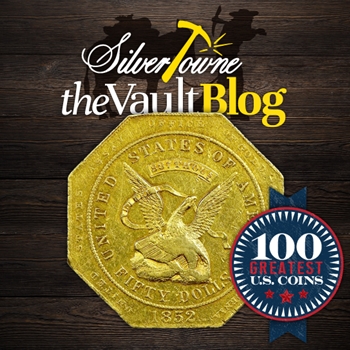
One of the most significant events to happen in the 19th century was the California Gold Rush. Beginning in 1848, the discovery of gold nuggets in the Sacramento Valley sparked a massive influx of people to make their way to the Golden State. While nearly $2 billion worth of the precious metal was ultimately extracted from the area, the discovery of gold created a different set of problems for the people who actually inhabited the area pre-Gold Rush.
By the end of 1849, nearly 100,000 people of non-native status were inhabiting the California territory in comparison to the previous less than 1,000. The dramatic increase of people in addition to inflation and the lack of gold coins for which was needed to conduct proper business, gold dust then became the means of currency. However, this form of currency came with its own set of issues as measurements varied and the owner of the dust suffered major losses because of it.
Next up in our 100 Greatest United States Coins series, we talk about the coin that was produced in order to combat the issues caused by the Gold Rush. With influence from the top dealers across the country, author Jeff Garrett with help from Ron Guth placed this coin on the list in the fourth edition of Whitman Publishing’s highly respected publication. Let us continue to find out more.
#60 - U.S. Assay Office $50 Gold Slugs
With a number of issues happening after the Gold Rush hit, a United States Assay office was opened in San Francisco in 1851. Augustus Humbert, who took the lead on the new office, got together with the firm of Moffat & Company to produce large $50 coins which were legally described as ingots. These coins had eight sides and were comprised of nearly 2.75 ounces of pure gold. Today they are known as “slugs” and are credited for creating a new level of confidence among the public. Because they were heavy and large in size, they ended up causing impure and underweight coins to go out of circulation.
Due to their legal nature of being ingots instead of coins, $50 slugs were not mandated as having to be 90 percent pure like other legal gold coins. Four different fineness designations appear on the $50 gold slugs because of this (.880, .884, .887, .900) and some of the earlier versions of them had lettered edges while later versions would appear to have reeded edges. What is even more incredible that the existence of these coins themselves is the fact that some of the varieties actually too as many as 14 steps to produce one.
Once operations began in 1854 at the San Francisco Mint, the $50 gold slugs were melted down and made into United States gold coins. Produced in large quantities back then, the eight-sided coin is an important reminder of the time that helped shape American history. While a number of U.S. gold double eagles were found in the wreckage of SS Central American in 1857, very few slugs were found. Many thought that upon finding the treasure, these $50 slugs would be more available but that was not the case.
The coin itself was designed by Charles Cushing Wright and Augustus Humbert. The obverse features an eagle on a rock clutching a shield, a bundle of arrows, and an olive branch. A scroll is seen it its beak while another scroll above the eagle displays the fineness of the coin. The inscription “UNITED STATES OF AMERICA” in addition to the denomination surround the eagle around the top and bottom while the outer edge remains plain or lettered depending on the variety of the $50 slug. The reverse depicts an engine-turned design that sometimes has a target in the center and other times with a “50” punched in the center representing its denomination ($50).
In 1960, these coins an extremely fine condition were valued at $1,500. Twenty years later, the value increased to $6,500. Over time and over the editions of this publication by Whitman, the current value of one of these coins, again in extremely fine, is valued at $50,000.







